5 Inspiring Ideas for Using OpenAsset Beyond Traditional Asset Management
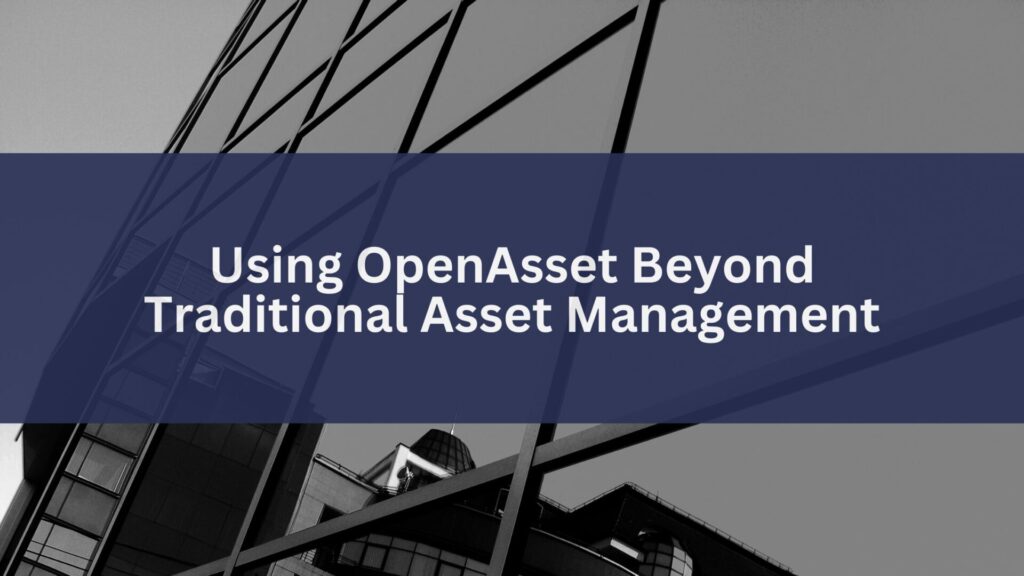
As a digital asset management (DAM) solution, OpenAsset has established itself as a leader for AEC professionals wanting to streamline their workflow and enhance project efficiency. However, if viewed through the lens of traditional asset organization and retrieval, many might not be aware of the platform’s full potential.
This narrow perspective overlooks OpenAsset’s capability to go beyond the typical DAM storage features, offering innovative solutions to various complex challenges faced by AEC firms today.
The essence of the problem lies in underutilization. Many users use OpenAsset for its primary function — organizing and storing digital assets like images, videos, and documents — yet they barely scratch the surface of its capabilities.
In this blog, we’ll bridge the gap between OpenAsset’s potential and its actual use in the AEC space by sharing five inspiring ideas that showcase how you can leverage OpenAsset beyond storage and organization.
What Is OpenAsset?
OpenAsset is a digital asset management (DAM) system designed for project-based sectors, such as architecture, engineering, and construction (AEC). It helps these organizations efficiently manage and leverage their vast amounts of digital content, such as images, videos, and documents.
OpenAsset streamlines storing, organizing, searching, and sharing digital assets across an organization, making it easier for teams to access and use these resources in their projects.
The platform offers robust features that cater specifically to the needs of project-centric industries. For example, it allows users to tag and categorize assets based on project metadata, making it simple to find relevant images or documents for a particular project.
OpenAsset can also integrate with other software tools commonly used in these sectors, such as project management and document creation tools. This enhances workflow efficiency and productivity.
Ultimately, the idea is simple: Centralize AEC assets. Create more proposals. Win more business.
Using OpenAsset Beyond Traditional Asset Management
Exploring OpenAsset beyond traditional asset management opens a world of possibilities for AEC firms looking to maximize their digital asset potential. Here’s how organizations can utilize OpenAsset in innovative ways:
1. Brand Management and Building Brand Kits
OpenAsset can serve as a powerful tool for brand management by allowing firms to curate and organize brand assets carefully. Companies can create comprehensive brand kits within OpenAsset, which include logos, standardized images, color palettes, typography, and any other brand-specific assets.
This centralized access ensures consistency across all marketing materials and communications, reinforcing the brand identity across various platforms and touchpoints.
Utilizing OpenAsset ensures that all data is consistent, organized, and readily accessible. This consistency is especially crucial for proposals, where accuracy and presentation can make a significant difference.
One example is a case study from Arcadis IBI Group. With OpenAsset serving as the single source of truth for all visual assets, Arcadis IBI Group saw a marked improvement in brand consistency. The shift from relying on stock photos to using their curated library ensured authenticity in every piece of marketing collateral.
Moreover, utilizing OpenAsset for brand management not only ensures brand consistency across all channels and materials, but also streamlines workflows, saves time, and enhances collaboration.
When discussing how OpenAsset fits into the larger proposal website during the Leveraging Your Projects and Your People to Win New Business webinar, Julie I. May, Archives Manager at Bjarke Ingels Group (BIG) mentions:
“Our communications team while we haven’t fully rolled out this workflow, it’s going to be aligned with the website, the new website— we’re going to use the albums for press kits. So all of those that are selected as the best and approved for use and have the necessary copyright information policies associated with them, we’re collecting those in albums and using that web share link to share with press inquiries.” —Julie May
2. Effective Digital Rights Management
Managing digital rights becomes increasingly complex as firms grow and their asset libraries expand.
However, as the digital environment and copyright legislation evolve, it becomes increasingly essential for businesses to safeguard their digital content and streamline the management of license details.
For enterprises overwhelmed by the management of a large collection of digital photographs, the task can be daunting for costly mistakes.
This is where implementing a Digital Asset Management (DAM) system, like OpenAsset, comes in. Utilizing OpenAsset allows you to reduce the complexity of management and diminishes the risk of financial liability by offering an efficient solution for overseeing stock photo assets, adhering to licensing agreements, and avoiding legal issues.
Specifically, OpenAsset helps manage the complexities of rights management by tracking the usage rights of assets within its system. By documenting licenses, expiration dates, and usage permissions directly within the asset metadata, organizations can safeguard against copyright infringement and ensure that all asset usage is compliant with legal requirements.
Additionally, assets can be marked with descriptive metadata, simplifying the search process and clarifying usage constraints for users.
Moreover, you can implement manual approval processes when necessary and restrict access to viewing only where needed. This grants businesses the ability to dictate the terms of photo usage, including who can use them, as well as when and where they can be used.
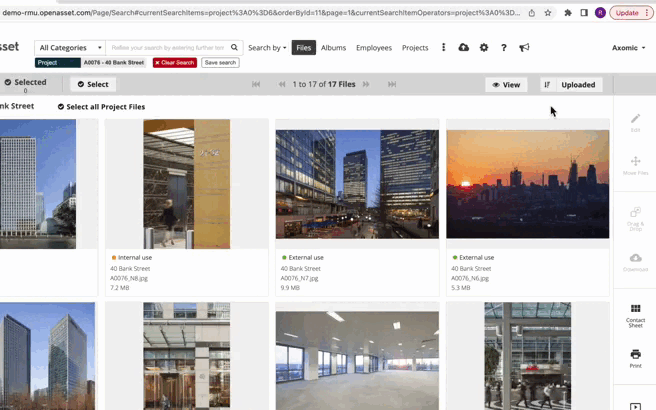
These capabilities are instrumental in maintaining legal compliance, avoiding copyright violations, and getting around possible legal ramifications. DAM systems make it simpler to pinpoint and administer assets that come with usage restrictions, thereby shielding organizations from legal vulnerabilities.
Regardless of whether the images are free stock photos or produced in-house, ensuring compliance with copyright laws and securing the use of image assets is crucial for companies. This is especially true for companies with extensive libraries of digital assets.
3. Robust Event Collateral Management
Managing event-specific collateral can be challenging for organizations that frequently host or participate in events, whether internal or external.
Utilizing OpenAsset allows you to organize event collateral, such as images, logos, and presentations, in dedicated folders or categories. This ensures that teams can quickly find and reuse materials, maintain consistency across events, and streamline the planning and execution process of event marketing strategies.
When you focus on people, that also means digital assets beyond resumes, like digital assets for events. OpenAsset brings firms closer to their people and events beyond resumes. To make managing event collateral easier, with OpenAsset, you can add different categories and keywords to search for events and store as many event photos as you want in the system.
During the webinar, Leveraging Your Projects and Your People to Win New Business when discussing how their respective companies use OpenAsset to store and share company culture assets, such as headshots, t-shirt designs, and event photos, in addition to project-related assets, Julie May, Archives Manager at Bjarke Ingels Group (BIG) mentioned the importance of capturing community spirit information and how it helps populate their website’s community page.
Moreover, Julie May also mentions the following use case at Bjarke Ingels Group:
“[The company] t-shirt usually has our logo on it with maybe the projects [that employee] has worked on and a unique characteristic of their personality. We put those t-shirt designs into OpenAsset, in addition to our holiday or event invitations. We have those twice a year. So all of those things bring a large and geographically spread out group of people together because they share that [company culture] through OpenAsset.” — Julie May
4. Efficient Collaboration for Brand Collateral
DAM enables effortless teamwork among colleagues, no matter where they are located. With a cloud-based DAM platform, graphic designers and other marketing team members can simultaneously access and modify assets, exchange files, and carry out reviews and approvals.
This enhances immediate collaboration, elevates efficiency, and reduces the chance of encountering problems with version control.
Utilizing OpenAsset facilitates the sharing and collaboration of brand collateral and licensed materials within and outside the organization through various methods.
By setting permissions and sharing settings within your OpenAsset system, AEC firms can control who accesses what, ensuring the secure distribution of materials.
Moreover, albums are collections of files within OpenAsset for personal use or sharing. They offer a flexible way of grouping files from different projects and can be shared with individual users or groups within your organization.
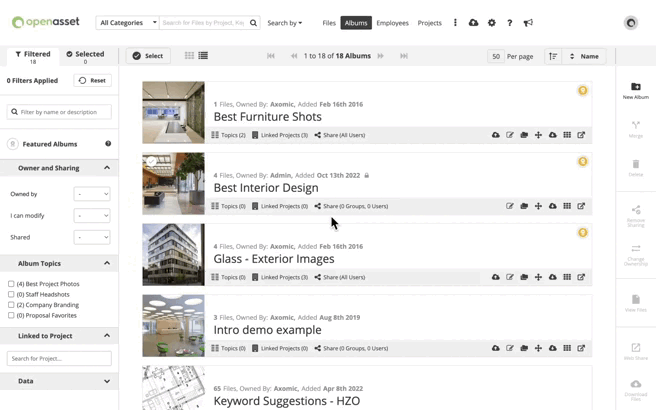
These features enhance collaboration among teams and with external partners, making it easier to work together on marketing collateral, presentations, and other AEC projects.
When faced with the challenge of collaboratively selecting photos to display online, Senior Graphic Designer, Kristine Svelha-Brown, from the Magnusson Klemencic Associates team, a valued OpenAsset client, from the Engineering sector, shared how OpenAsset helped their website redesign that would include a new project showcase:
“OpenAsset allowed our team to collaborate seamlessly on our image choices for display on the website. With hundreds of images per individual project, the marketing team was able to create and share albums among the decision makers, vetting each project’s ‘collection’ down to 5-10 key images. This allowed us to tell the essential story of each project visually. We currently display over 1,400 project images on our website.” —Kristine Svelha-Brown
5. Save Time With Asset-Based Workflows
Automating and streamlining workflows is another key benefit of utilizing OpenAsset beyond traditional asset management. By designing asset-based workflows within the platform, firms can automate repetitive tasks such as asset approvals, tagging, and categorization.
This not only saves time but also ensures a consistent approach to asset management across the organization. For example, setting up automated workflows for the approval process of new assets can help maintain quality control.
Approval Workflows
Setting up approval workflows helps maintain control over the quality and compliance of assets within your library. OpenAsset supports a File Approval process where newly Uploaded Files are queued for approval by specific people within your organization. Once the Files are Approved, they are made available for use in the DAM software.
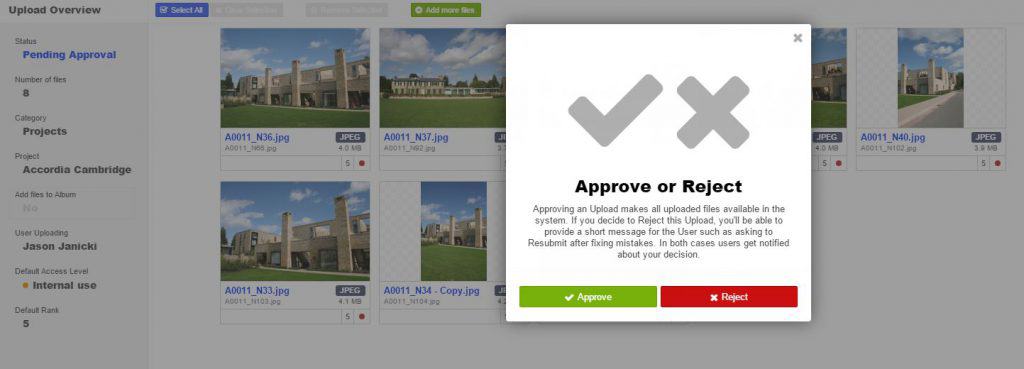
By putting in place an approvals process, you can establish a ‘gatekeeper’ approach to uploading whereby library Admins must approve images before they become available in OpenAsset. This ensures that only approved assets are available for use, maintaining brand standards and copyright compliance.
In addition to controlling which images are added to your system, this process allows Admins to more closely control which keywords and metadata are applied to assets at the point of upload.
When faced with the challenge of finding a better process and tool for photo management, a valued OpenAsset client in the Engineering sector, shared how their team leveraged OpenAsset to give employees controlled access to approved photos:
“That’s the advantage that we have now; we have a robust system that allows us to tell the story, not only about that individual photo, but who owns it, who uploaded it, and the traffic lights system tells whether the image is approved. This has improved our process immensely.” —OpenAsset Engineering Client
Automated Tagging and Categorization
Suggested tagging and categorizing new assets when uploading them to OpenAsset can save you and your team considerable time.
By using predefined rules and AI capabilities, OpenAsset can analyze assets and suggest relevant tags based on content, project metadata, or other criteria. This ensures assets are organized and searchable from the moment they enter the system.
Asset tags can be tailored, including client names, project codes, and other specific information, enabling precise asset categorization and simplification of searches for particular campaigns or projects.
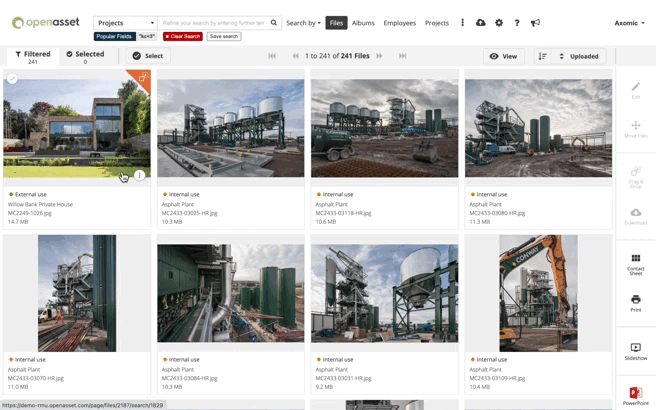
Additionally, tagging facilitates easy organization and retrieval of images by categorizing them, enhancing search efficiency for users.
When faced with the challenge of finding a solution robust enough to handle their growing image library, Image Library Coordinator, Gemma Goulder, from the Mace Group team, a valued OpenAsset client in the construction sector, shared how OpenAsset led to firm-wide access that allows employees to find the images they need, from anywhere in the world:
“We created different categories to manage employee photos, event photos, infographics, and project photos separately within OpenAsset. The library has been widely adopted throughout the organization. End users can find the photos they need quickly and easily, without asking me where images are.” —Gemma Goulder
Using OpenAsset for Improved Workflows
Leveraging your OpenAsset system to its full potential can transform how your organization manages digital assets. By moving beyond traditional asset management, OpenAsset becomes not just a tool for organizing digital assets but a powerhouse for enhancing productivity, collaboration, and brand management.
Implementing innovative practices such as asset-based workflows, digital rights management, and seamless collaboration ensures that your team can work more efficiently and creatively.
Making the most of your OpenAsset system means embracing its capabilities to the fullest. By doing so, you not only optimize your asset management workflows but also contribute to the overall success and growth of your business.
OpenAsset is more than just a digital asset management tool; it’s a gateway to unlocking greater efficiency, collaboration, and innovation within your organization. Ready to give it a try?
The post 5 Inspiring Ideas for Using OpenAsset Beyond Traditional Asset Management appeared first on OpenAsset.